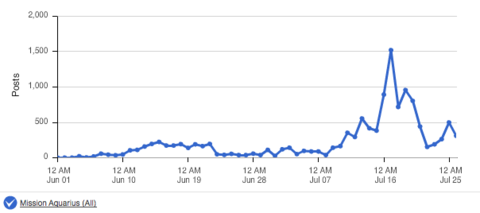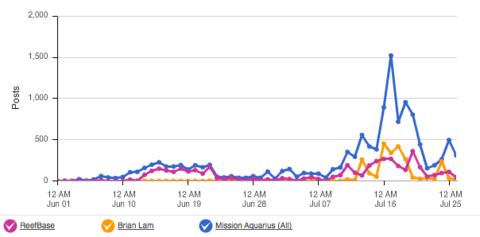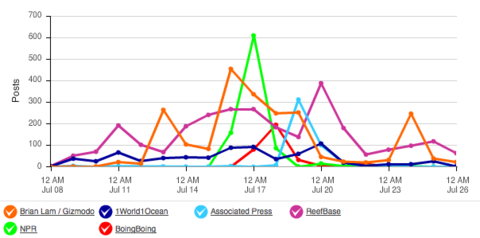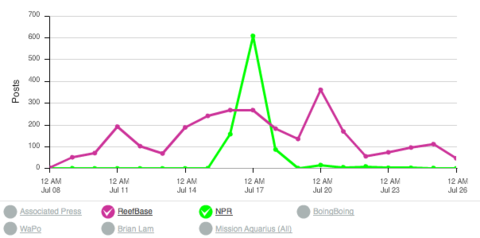Unpacking Social Mentions of Mission Aquarius
Mission Aquarius has taken its bow, after several aquanauts spent a week from July 14th to 21st underwater at the Aquarius Reef Base off the Florida Keys. The project received plenty of major mainstream media attention, from NPR to the Washington Post to Fox News and even The Daily Show with Jon Stewart.
But how did it fare in online social mentions?
Upwell tracks social mentions because they're a concrete action. Creating a blog post, retweeting or posting a video is a bigger deal than just viewing content. We track ocean content makers. These makers drive the online conversation," says Rachel Weidinger.
Note that our tracking of social mentions is different from the more common metric of tracking impressions, like views on YouTube videos. We count social content as it is posted online, tracking posts with keyword searches. This social mention metric has more in common with the metric of media hits than it does with the metric of impressions.
To kick things off, here's a graph that shows overall online social mentions of Mission Aquarius from June 1-July 26:

Social mentions of the Mission Aquarius keyword set June 1-July 26, 2012 developed by Upwell
The grand total: 12,559 social mentions of Mission Aquarius. That's 12,559 times an individual took the time to create online content specifically mentioning Mission Aquarius.
Now, let's break that down a little.
Two Influencers Created Half the Attention
Many people and news outlets were speaking about Mission Aquarius. But online, the bulk of these social mentions were the result of just two sources: @ReefBase, the official Mission Aquarius twitter account (4,375 mentions since July 1st), and ocean tech journalist (and former Gizmodo Editor) Brian Lam (2,514 mentions since July 1st). This graph shows the contributions of these two sources to the overall spike:

Social mentions of the Mission Aquarius keyword set by Mission Aquarius (blue line), ReefBase (purple line), Brian Lam’s posts (orange line) June 1-July 26, 2012 developed by Upwell
Total social mentions for Upwell’s keyword groups for Mission Aquarius (blue line): 12,559; ReefBase (purple line): 4,375; Brian Lam’s total posts (orange line): 2,514.
The Wave Crests
As the close of the Aquarius base drew nearer, social mentions steadily increased. The largest wave of social mentions began to rise on July 8th (with tweets from @ReefBase, @SylviaEarle, @blam, @1World1Ocean, @MissionBlue and others) and crested on July 17th (with a story on NPR’s “Morning Edition”). Here’s a graph that breaks out (or “unpacks”) a selection of the contributors to that wave:

Social mentions of the Mission Aquarius keyword set by main influencer July 8-July 26, 2012
What this graph shows is the contributions of a number of different sources. We can see that @Reefbase and Brian Lam's Gizmodo posts scored a high number of social mentions, as did One World One Ocean and BoingBoing. Among traditional outlets, NPR and the Associated Press had notable spikes. In particular, there is one big spike on July 17. But how does that spike compare to overall social mentions? Let's take a look.
Continuing Engagement Beats Short Spikes

Social mentions of the Mission Aquarius keyword set for ReefBase (magenta) and NPR's Morning Edition (green) June 8-July 26, 2012 developed by Upwell
That spike came as a result of an item on NPR's "Morning Edition" - which generated 897 online mentions,the most of any single event. Note, however, that the spike is just that: a spike. It doesn't last, not even a little bit. In contrast, @ReefBase mentions continued steadily throughout the month, with an overall total of almost 3,500 more than NPR. Why? Because @ReefBase engaged with their audience throughout the month, building an audience -- and a conversation. Conversations are engines of attention: add content and engagement and they generate social mentions, often at a far more steady state that news media stories, which tend to spike quickly and then vanish, with little trace and even less impact on the ongoing baseline of social mentions.
So What Have we Learned?
1. Online mentions come from online sources: Of the 12,559 mentions of Mission Aquarius we measured, more than HALF of those were directly attributable to two savvy sources only: Brian Lam, and @ReefBase. The nearest traditional media source was NPR, which had fewer than 1,000 social mentions. It may seem obvious, but the way to drive online conversation is through online sources, rather than traditional media.
2. Putting the effort into one or two major online sources pays off: Mission Aquarius made the effort to invite Brian Lam to be involved closely with the project for a lengthy period, and it paid off. It's an important lesson for ocean communications professionals: Whenever possible, find a blogger or writer at a major online source, particularly if that blogger is predisposed to ocean issues, and sell them on your story, as early as possible.
3. Keep the conversation going: By maintaining a lengthy conversation in the build-up to and during Mission Aquarius, Reef Base showed that engagement beats spikes, even big spikes from major media outlets - and beats them by a significant degree. It is further evidence that it isn't enough any more to simply issue press releases or post links. For a sustained online 'bulge', we have to engage readers and others in an ongoing conversation.
Add a comment